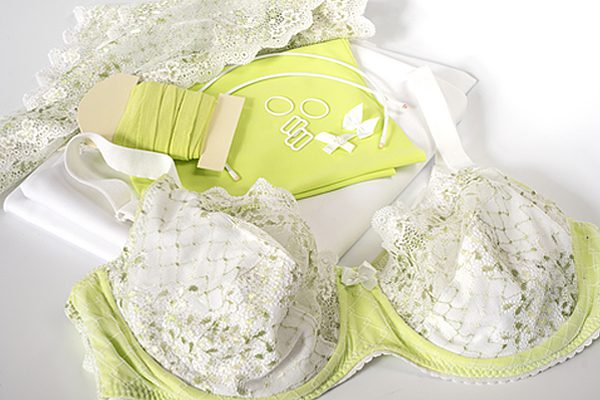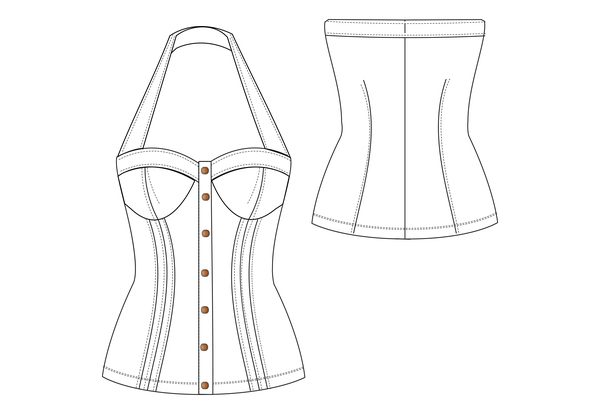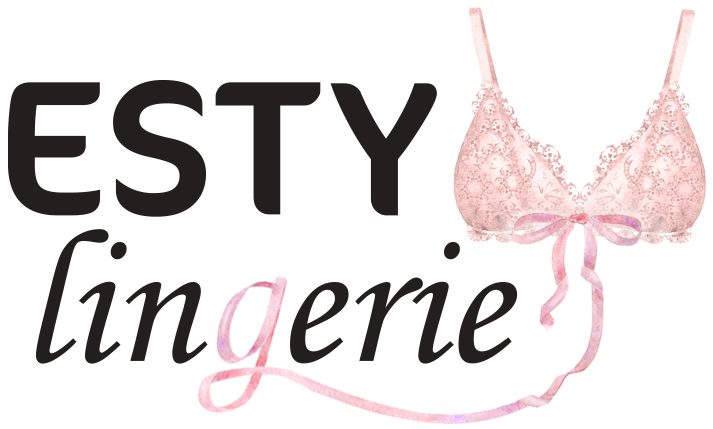I kicked off the Careers in Lingerie blog series by speaking to Ayten Roberts who has her own brand, but there’s more than one way to be a lingerie designer and they don’t all involve the endless admin that comes with running your own boutique. I’m also going to be speaking to a few lingerie designers who’ve taken a different route, starting today with Laurie van Jonsson of How to Become a Lingerie Designer.
Like Ayten, Laurie has at one point run her own brand, but nowadays she’s a freelance designer creating ranges for multiple brands. Here she speaks about designing freelance vs. in-house, the myriad things that ‘designing’ actually involves, and how your first graduate role could shape your entire career.
Estelle: Hi Laurie, thanks for joining the Careers in Lingerie series! Could you tell my readers a little bit about yourself and the brands you’ve designed lingerie for?
Laurie: Thanks Estelle, I’ve been designing lingerie for about sixteen years! After I graduated I worked for a UK manufacturer which looking back now I was so lucky to do, as there aren’t many UK manufacturers left, so I really got to see the processes from start to finish. In this company we designed for the UK high street – Topshop, River Island, Next, Tammy Girl, and Etam.
From then with the need to travel, I bought a one way ticket to Thailand and whilst learning to dive got to know the owner of a swimwear shop, and ended up staying out there for a while and designing swimwear for her in European sizes. From there I headed to Belfast to live where I established my own lingerie brand Vanjo which catered for small backs and big boobs, which led me to writing lingerie books. But anyone who has travelled knows that that need to keep seeing new places still stays with you, so I secured a job within Melbourne Australia, gained sponsorship and worked for a company out there designing for the Australian high streets.
After ten years of living abroad I headed back to the UK to work on my company Vanjonsson Design full time, which includes freelancing for lingerie companies, running my website How to Become a Lingerie Designer, writing about lingerie and producing patterns which you can buy.

Betsy knicker sewing pattern by van Jonsson
E: You studied Contour Fashion at De Montfort University so I imagine you knew from the start that you wanted to design intimates. What drew you to lingerie over other areas of fashion design?
L: When I was leaving school I had secured a place at Loughborough Art college, as I didn’t really know what direction I wanted to head in. I loved altering clothes (my poor wardrobe didn’t survive my love of using scissors and re-sewing / re-hashing garments back together) and playing around with fabrics. I toyed with getting into fashion but at 18 years old, the industry intimidated me a little and I didn’t view myself as fashionable. As for the clothes I tried to make, I never had enough floor space to cut them out or ended up spending so much on fabric for the garment not to turn out right.
The spring before I left school I saw a programme about lingerie design and knew that was what I wanted to do. I loved the way that you could change the whole way you feel just by garments that no-one else saw. I also liked the idea that it wasn’t just about designing pretty lingerie, it was about how it fitted as well. I loved the technical side of things.
I ended up writing a letter to De Montfort and found out you could do a late entry application and it would be on a points-based system to get in, not on a portfolio viewing or interview. This was a good thing as when I told my art/sewing teacher I was changing my mind and going to De Montfort University, she told me it was a bad idea as my sewing was awful and I didn’t know anything about the industry – she was right but that didn’t stop me.
E: Would you recommend the same course for other hopeful lingerie designers?
L: Yes. Although I don’t think it’s necessary to do a degree, a degree gives you the space to try out new ideas, the resources to use and the time to gain knowledge from people who have worked previous in the industry. It also gives you a chance to build up your portfolio.
What I also think it does which is important, is give you a time structure for when to complete things. If you don’t have the money to do a degree then you should plan out your time to get things done. How many of us have dreamed about a new career and realised that a couple of years have passed from having the original idea of a career change? Although I don’t think you always need a degree, I do think that some sort of course is helpful, such as making patterns, as it will save you time in the long run. Working out everything yourself can be very time consuming and disheartening if you’re not getting it right.

Costing – a big part of lingerie design.
E: I’m sure some people think lingerie designers just sit around drawing pretty pictures of bras all day, but more goes into it than that! For those wondering if lingerie design is the right career path for them, what can they expect to be doing exactly once they land a job?
L: Drawing/planning out next season’s range including trend boards is such a small part of being a lingerie designer. Your day is spent juggling future seasons, getting them sampled up, getting them fitted, altering the patterns, going for second fits etc. Costing the garment, going back and forth with the buyer and factory to settle on a cost, altering a design so it fits the cost…
Then you’re juggling with the orders that are to be delivered, making sure they are on time, and sorting out everything when it goes wrong – deliveries late, wrong fabrics, different fits from the first sample, wrong shade of components to the one that was chosen. A buyer changing their mind over a colour.
With everything moving so fast and in some cases with a three-month turnaround, you do spend a long time on your timeline spread sheet making sure everything is where it needs to be. You need to be able to build good relationships with the buyer you’re working with and the factories. Some mornings I would get to work and there would be 50+ emails waiting for me to be answered, so you need to be able to make decisions quickly and have a good organisation system.
E: Is there anything that’s surprised you, that you didn’t know would be part of the role of a lingerie designer?
L: When I started out it was quite easy to move between positions, e.g. designer to grader to account manager, but nowadays it seems rarer to be able to do that. Also I found it near impossible as an employee to switch between different styles of being a designer. For example my roles have been mainly supplier-based – which means the company you work is an independent company and provides lingerie to different shops/brands. You’re not working for just one company, so if I’ve ever applied for a job opening of working for just one brand, the feedback I’ve received is that I’ve not the experience of being dedicated to working for one brand.
Also having been mainly designing for the high-street has meant that applying for designer lingerie brands hasn’t been successful. Working though as a freelancer has worked opposite; my CV shows that I can design in a multitude of styles so this has opened doors for different companies. So if you are planning to be a designer for a certain area of lingerie it’s best to try to secure that area near the start of your career as it’s hard, though not impossible, to change it later unless you freelance.

E: So having worked both in house and freelance, how do the two differ in terms of a typical working day, regularity of work/income, responsibilities etc.?
L: In-house you have the security of a wage, but the higher you progress the more you delegate the work so you’re responsible for a lot more, as you’re seeing everything from start to finish season after season. Whereas freelance you may be brought in for just one section or one season. In-house your working hours are regular, you have your nights free and your weekends, whereas freelance it’s more of a balancing act.
I like freelance as you seem to work on lots of different things. My main clients employ me usually for the technical side; they have the design already done and I work out their spec sheets, write up their tech packs, draw up their designs, attend fit sessions etc.
I have two small children at the minute so freelance works perfectly. Although in house I earned far more (peaking at £45,000+) freelance allows me to have flexibility to look after both of them and still work. I also have more creative satisfaction working freelance.
E: You mentioned you also had your own lingerie brand, Vanjo, which existed from 2005 to 2009. Have you preferred running your own brand or designing for other companies, and why?
L: Having my own brand was amazing. I don’t think I realised how well I was doing at the time, I was the first independent brand to be stocked by Topshop that provided bras above a DD cup. But having worked in the industry prior, at the the time I always thought I should be doing more. I was so use to the fast-paced fashion side of things, it was a bit of a shock to be the one doing everything and the time it took to do it all.
Having your own brand, though you are responsible for everything, one thing I did miss was other people. But when people wrote to me saying how much they loved my brand and how it fitted it did make it all worthwhile. I did learn a lot doing it all myself, and would definitely do it again.

E: Obviously, to become a lingerie designer you need a certain amount of knowledge about how bras are constructed. Aside from technical expertise though, what do you think it takes to be a successful lingerie designer?
L: Flexibility. Sometimes you have a great design and you have to be prepared to let it go and be altered or criticised. When you design something there are so many people who have their opinion – the buyer, the fitter, the sample machinist, the factory, even your boss who may not have any knowledge about designing! You need to pick the best advice and be prepared to alter your design, or be prepared to state your case why what you designed doesn’t need altering. You also need to be always keeping an eye on the market and constantly be knowledgeable about what’s going on around you.
E: Thanks for taking the time to tell my readers about your job! Where can they find you online?
L: www.howtobecomealingeriedesigner.com
www.instagram.com/vanjonssondesign
www.pinterest.com/vanjonssondesign
www.twitter.com/vanjonsson
Facebook – how to become a lingerie designer
laurie@howtobecomealingeriedesigner.com
I’ve also started to do #transformationtuesday on Instagram which basically is your chance to ask me any question or advice about the industry, designing, patterns, grading, starting your own label etc.
—
Enjoyed reading this interview? Subscribe to the blog here to make sure you don’t miss the rest of the Careers in Lingerie series, where I’ll be talking to other types of lingerie designer as well as people working in all different roles of the industry.
Did you realise that lingerie design involved so much more than actual designing? Have any other questions about life as a freelance lingerie designer? Leave a comment below!



2 comments
Hi
I’m Christelle and I’m about to launch my own lingerie brand. I would like to know if you design lingerie for others brands, if so, what can I do if I want your services.
Hi Christelle,
I don’t, but you can find out more about Laurie’s services on her new website here: https://vanjonssondesign.com/work-with-me